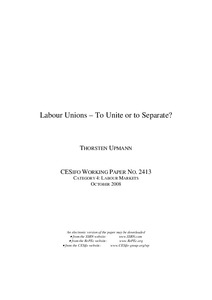Labour unions - to unite or to separate?
"In this paper we investigate trade union formation. To this end we apply a model with two types of labour where the interests of both groups of labourers are represented by either a joint (industry) labour union or by two independent group-specific (professional) labour unions. We investigate...
| Main Author: | |
|---|---|
| Institution: | ETUI-European Trade Union Institute |
| Format: | TEXT |
| Language: | English |
| Published: |
Munich
2008
CESifo |
| Subjects: | |
| Online Access: | https://www.labourline.org/KENTIKA-19180793124919089759-Labour-unions---to-unite-or-to.htm |
| Summary: | "In this paper we investigate trade union formation. To this end we apply a model with two types of labour where the interests of both groups of labourers are represented by either a joint (industry) labour union or by two independent group-specific (professional) labour unions. We investigate whether, and if so, under which conditions, it is beneficial for at least one group of labourers to form its own independent union; or whether it is in the interest of both groups to have a joint industry labour union. Applying the (asymmetric) Nash bargaining solution, we find that under reasonable conditions, it is beneficial for at least one group of labourers to form its own independent labour union. In this case a joint union must be considered as an unstable institution. The profit share, however, is always higher if the firm bargains with a joint labour union. This explains why employers vehemently oppose recent split offs of specialized labour groups from existing industry unions and from tariff unions." |
|---|---|
| Physical Description: | 29 p. Digital |

